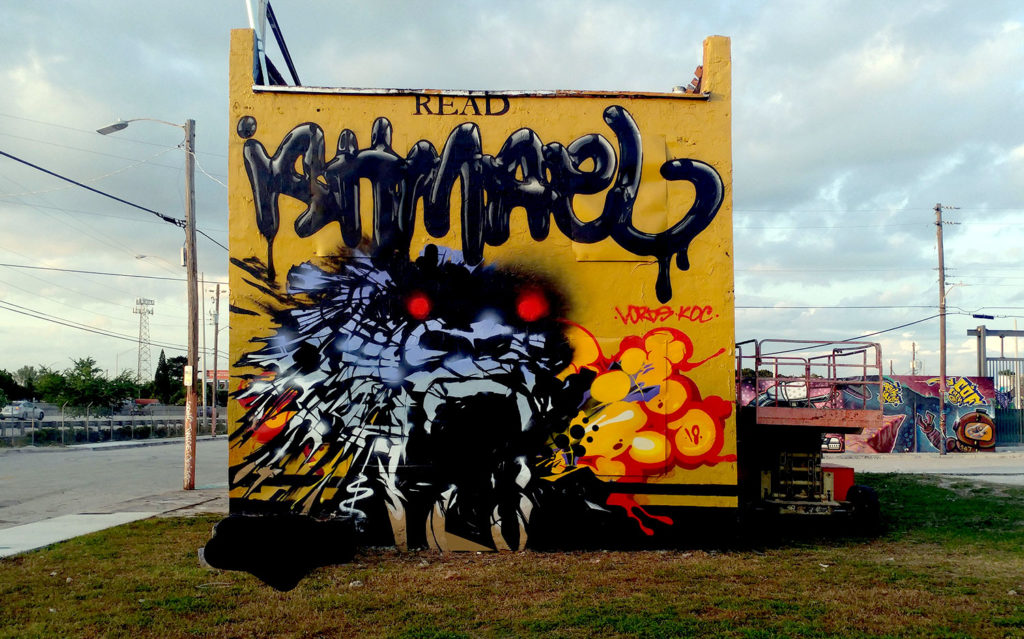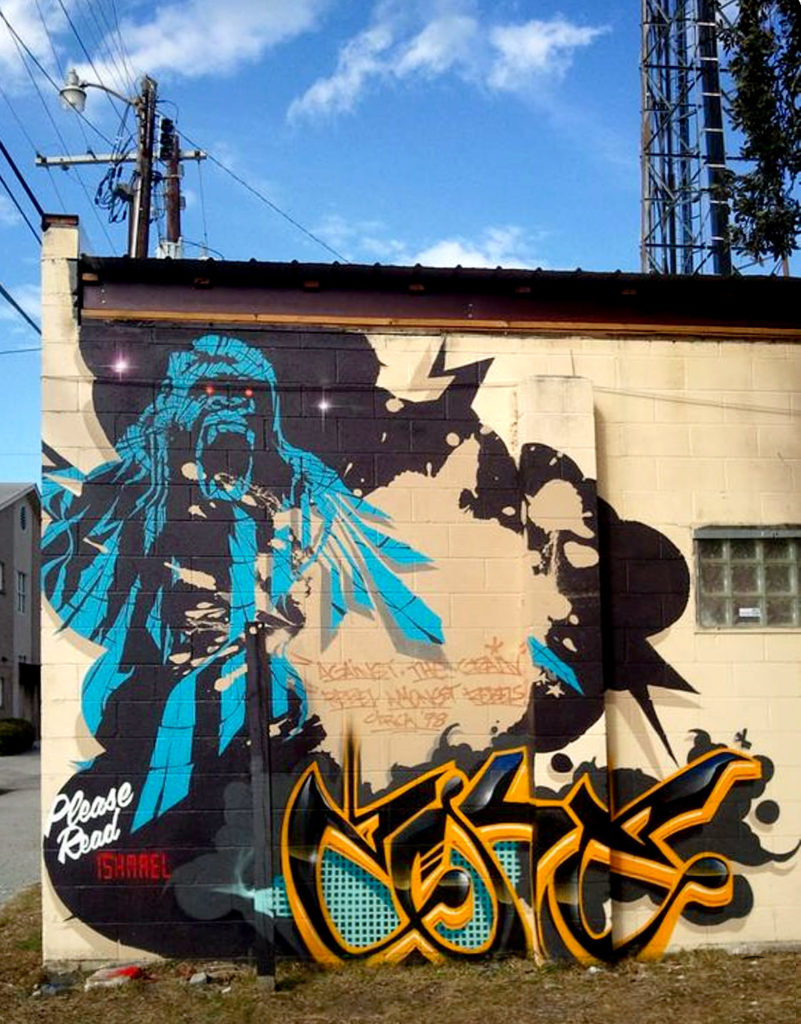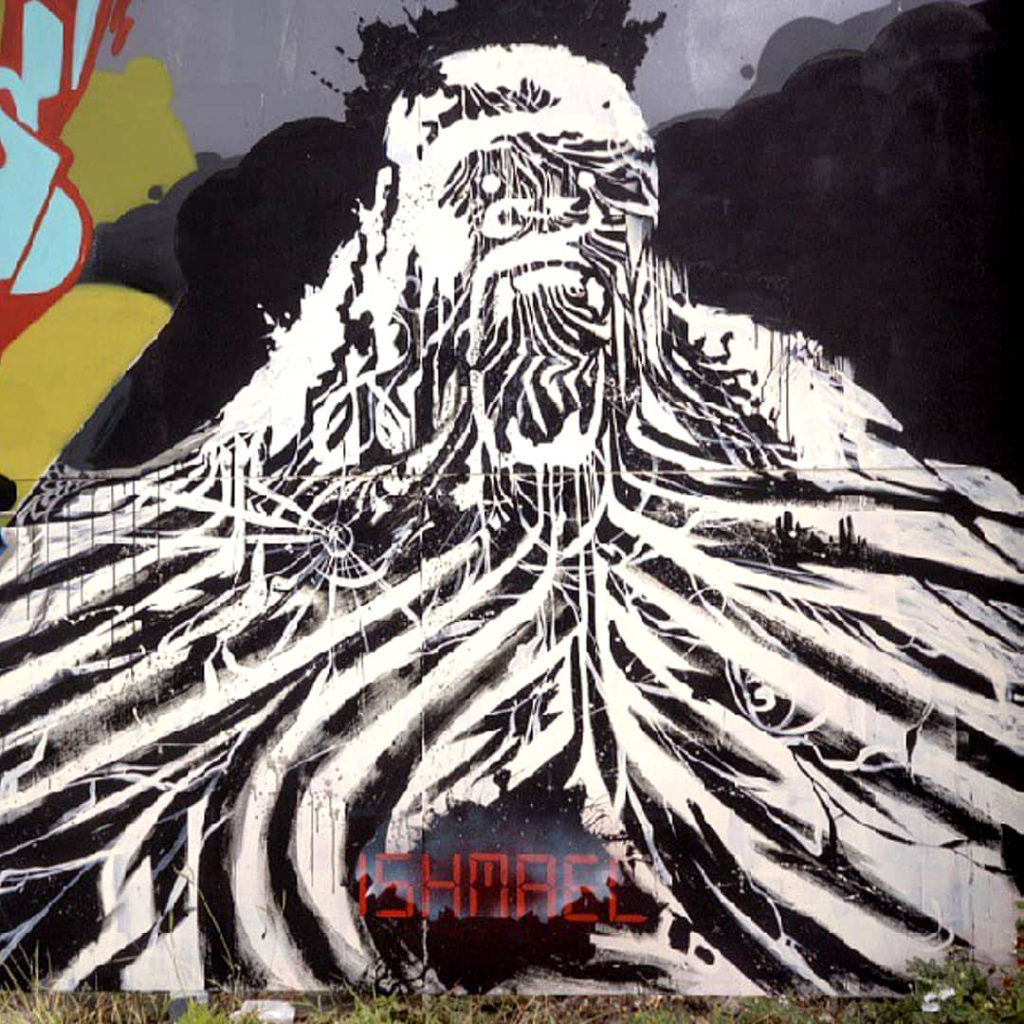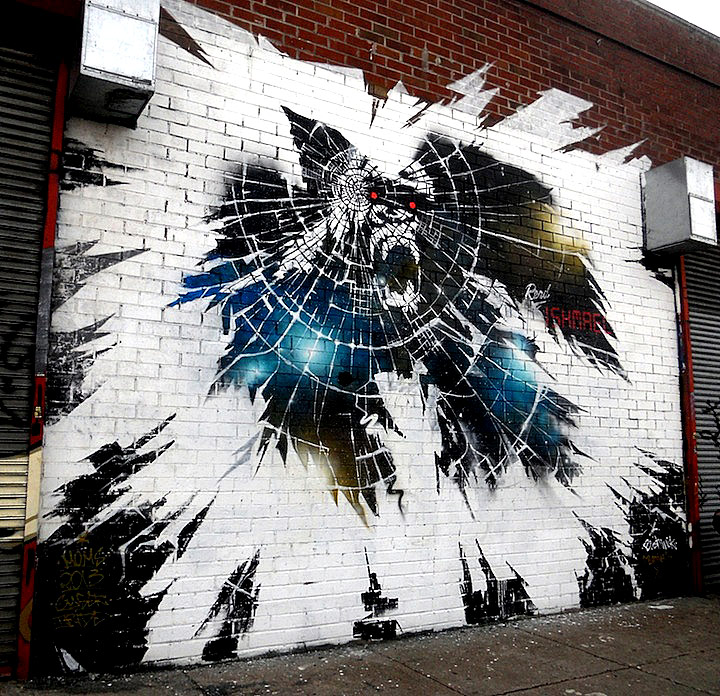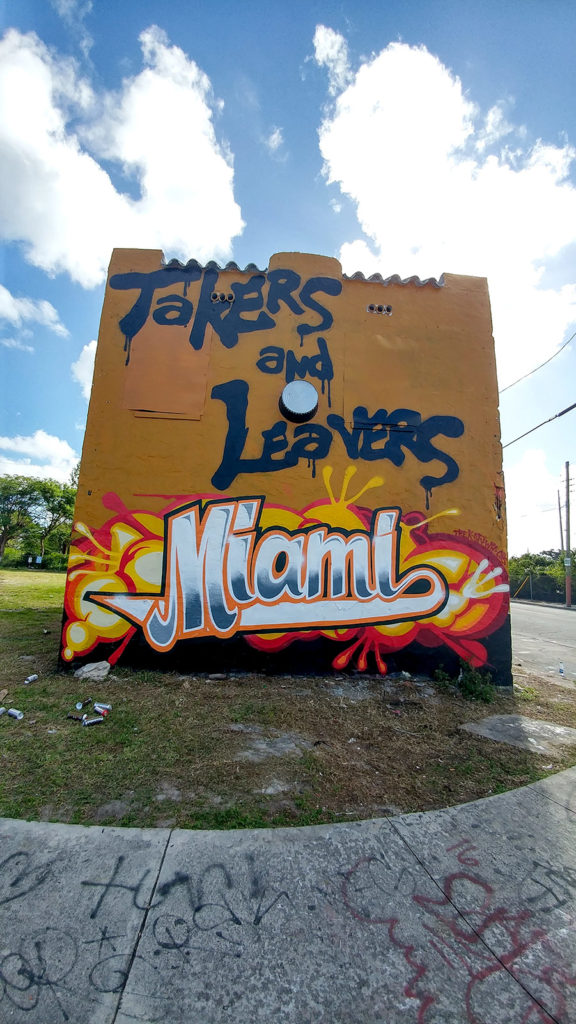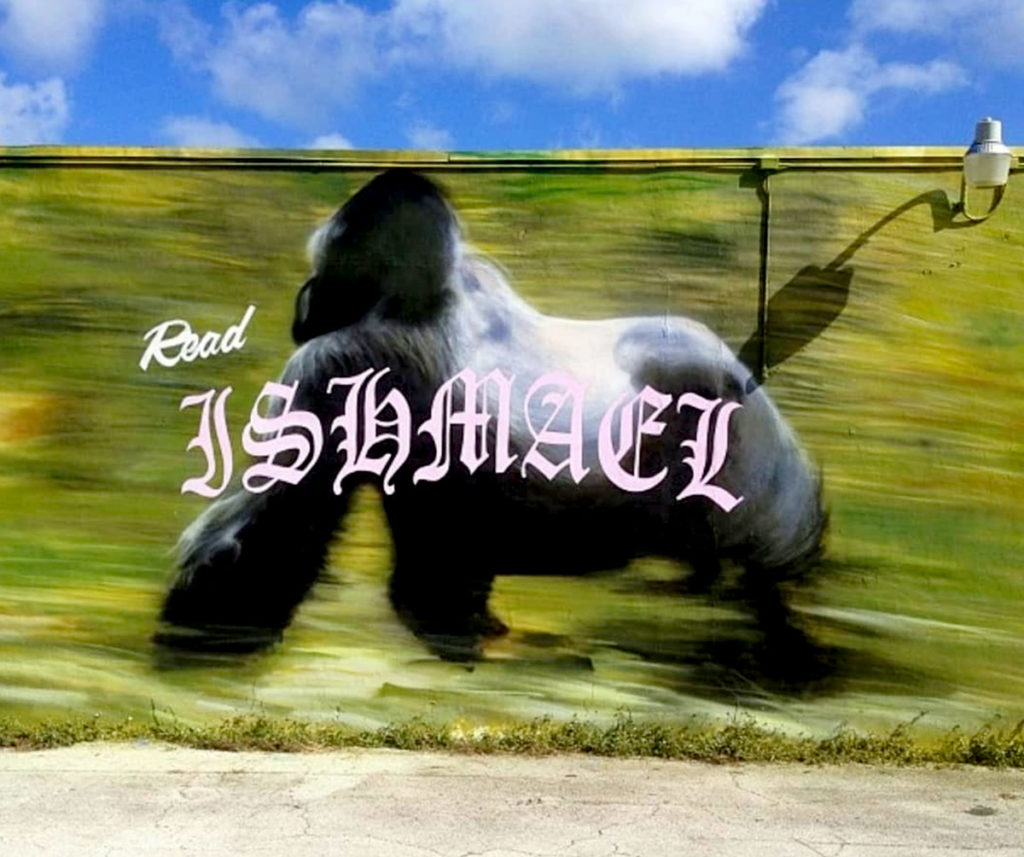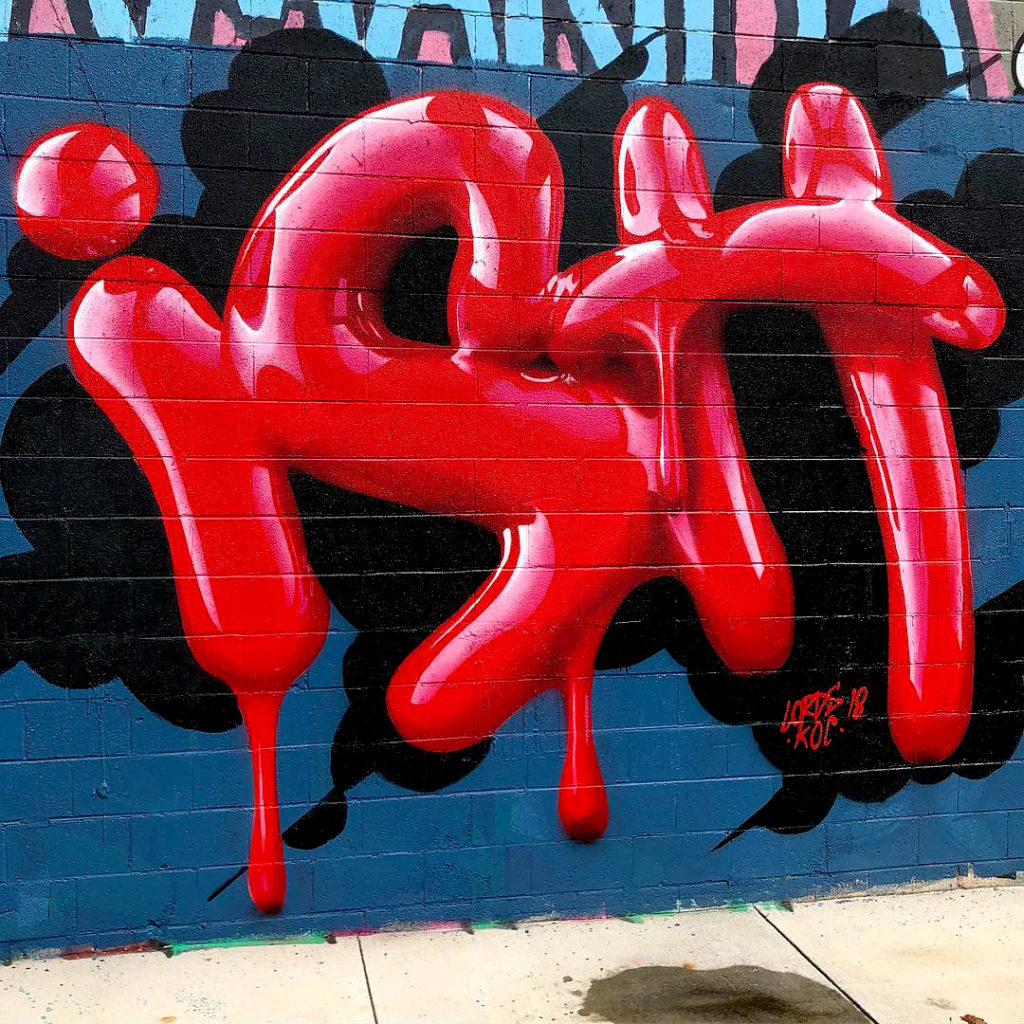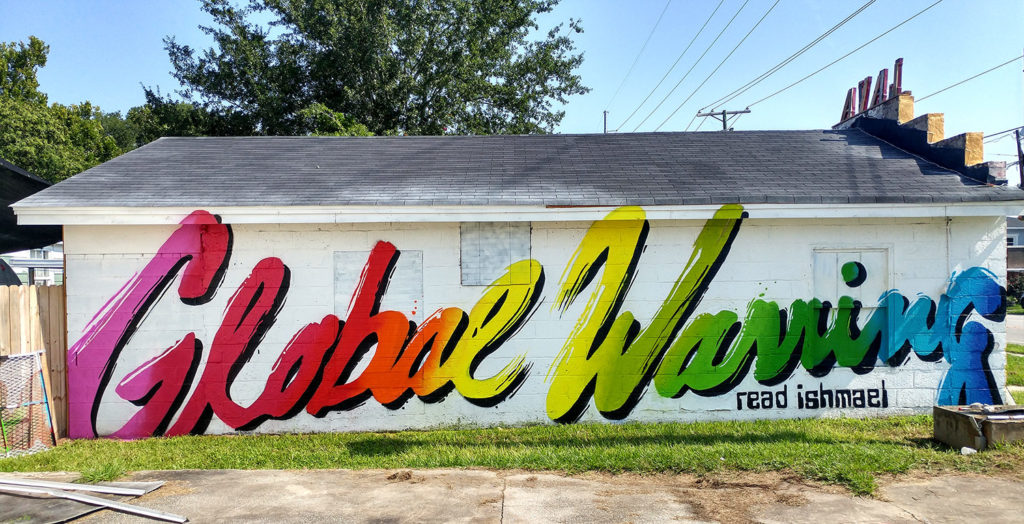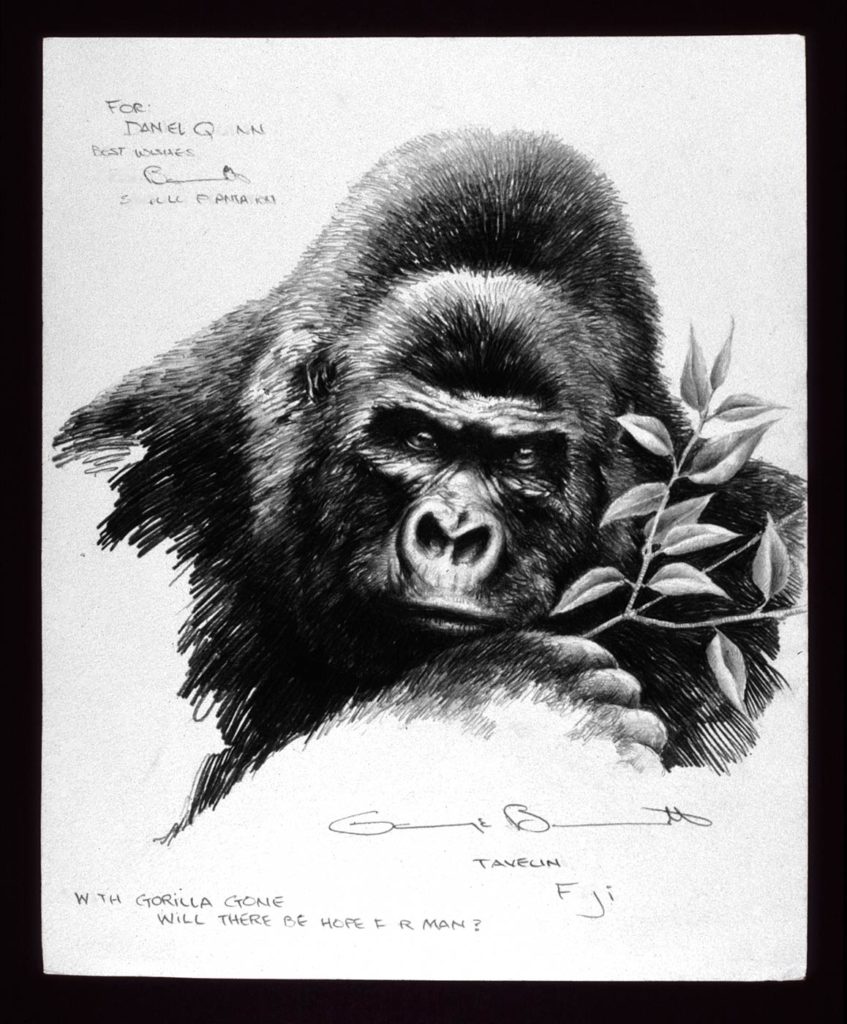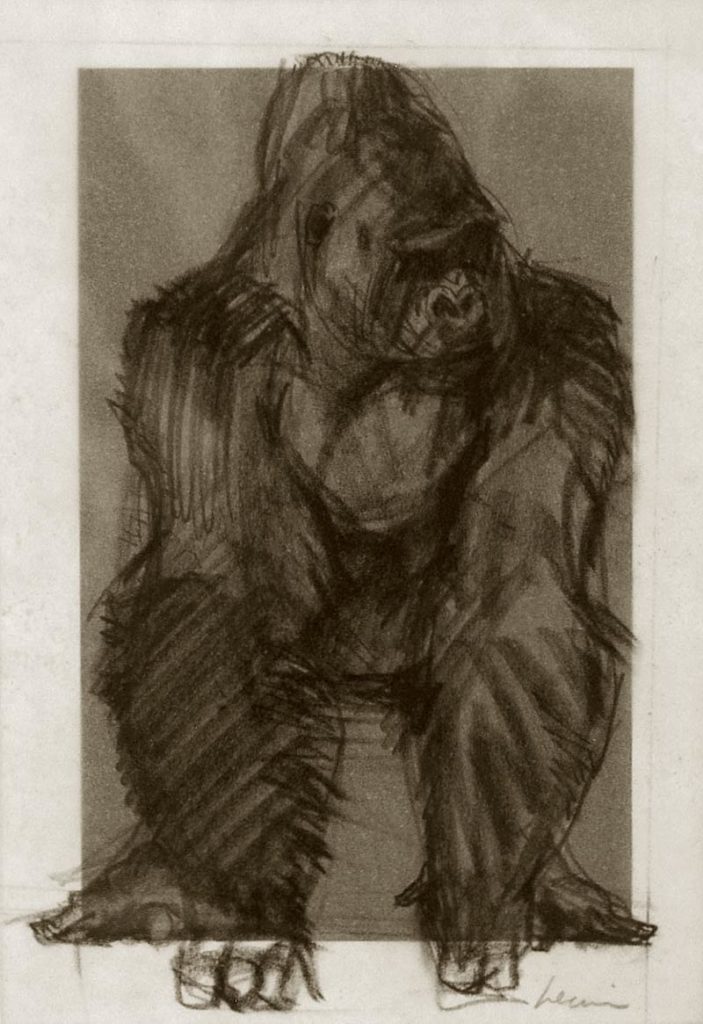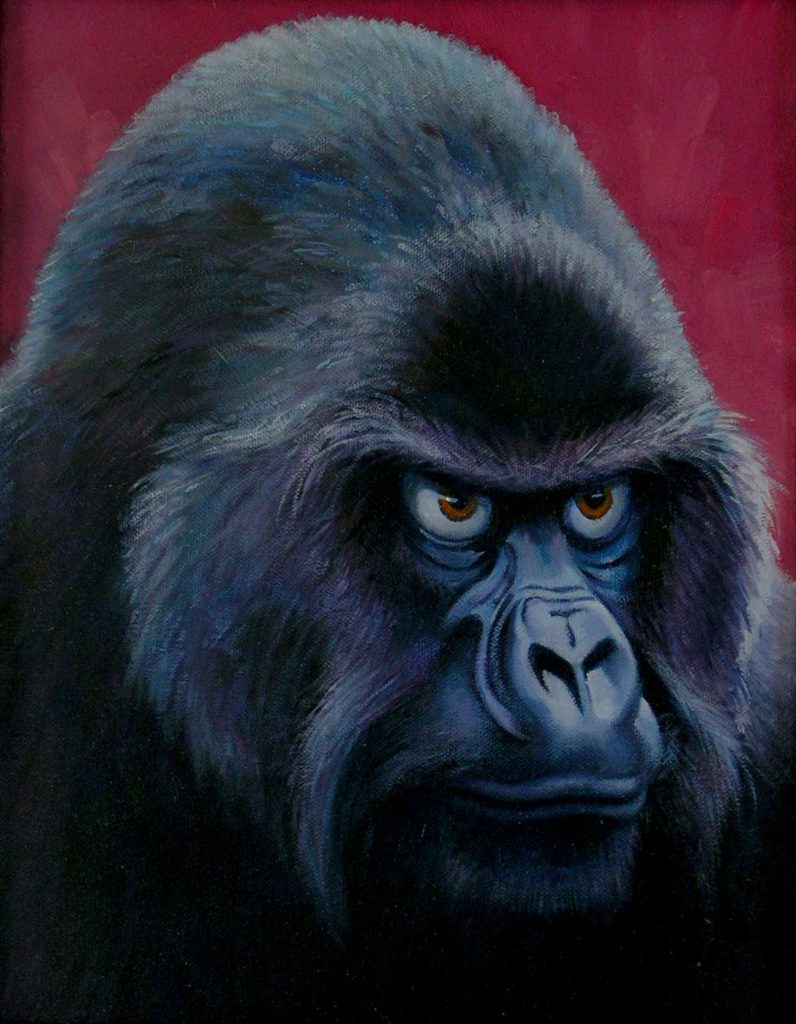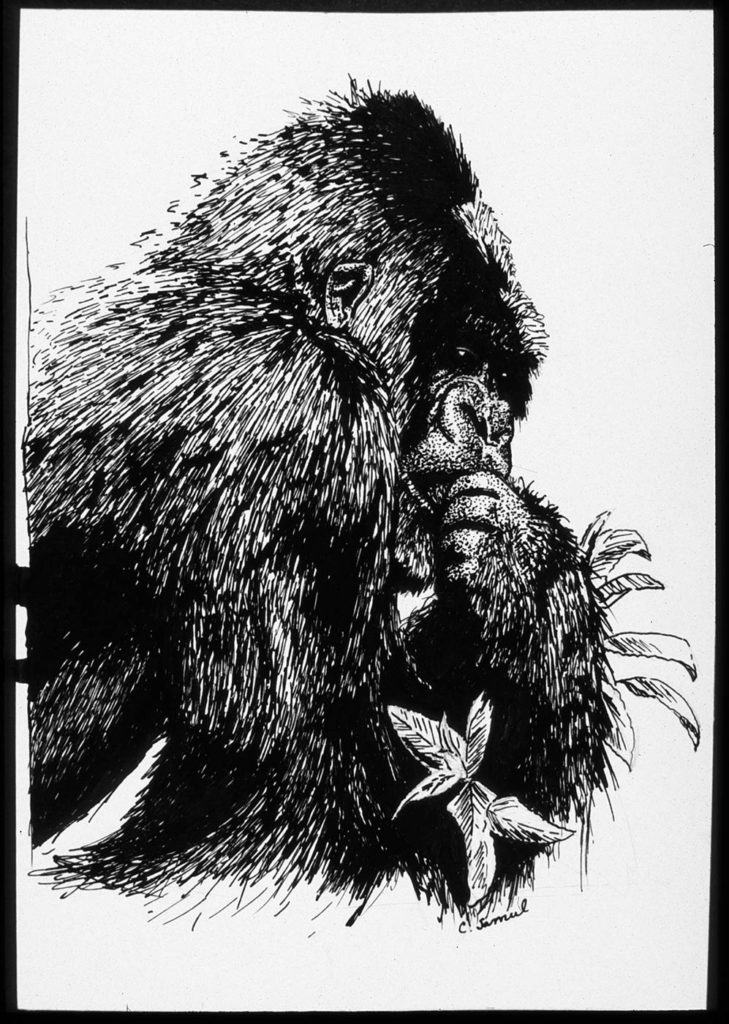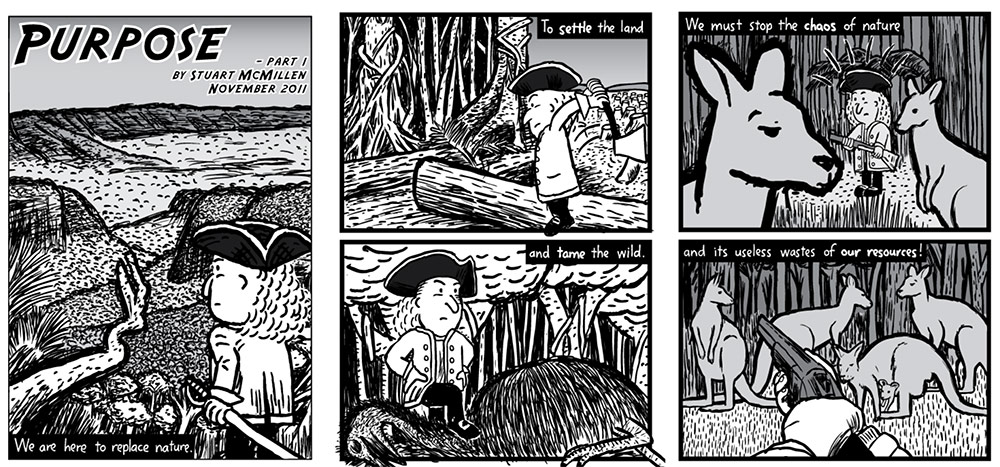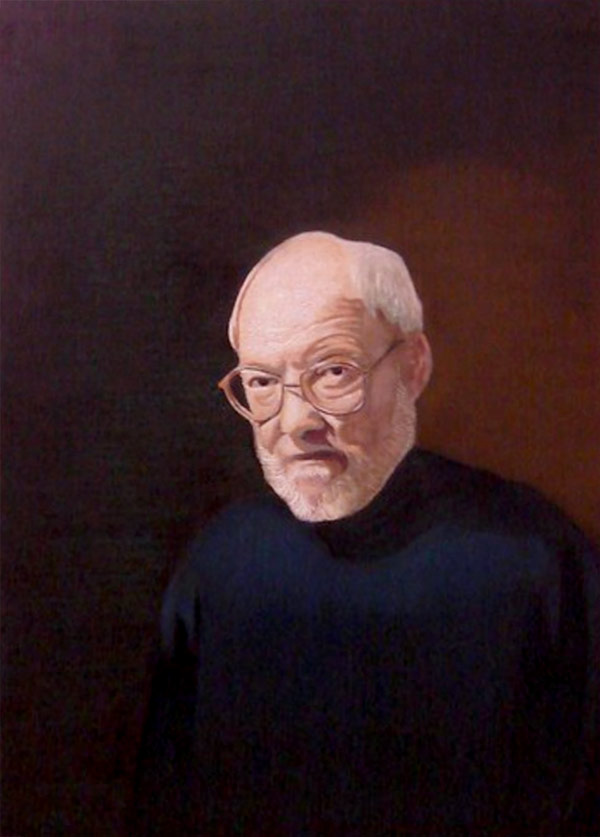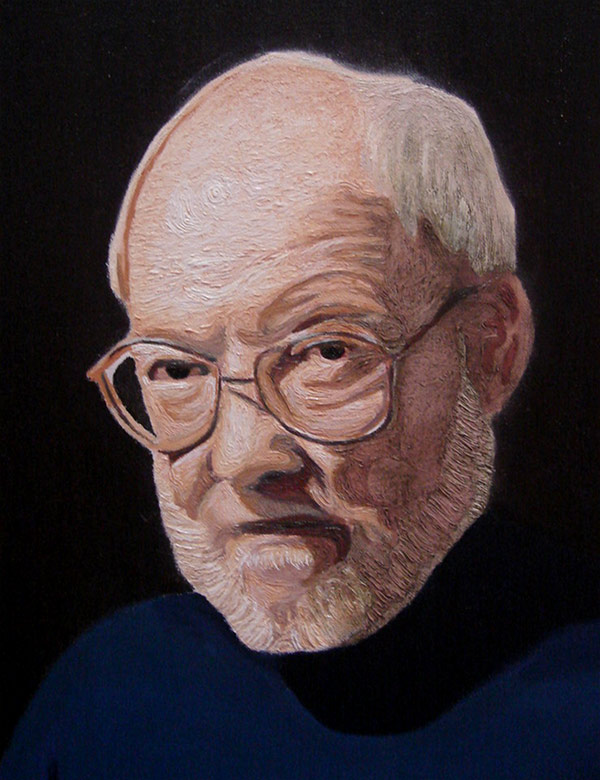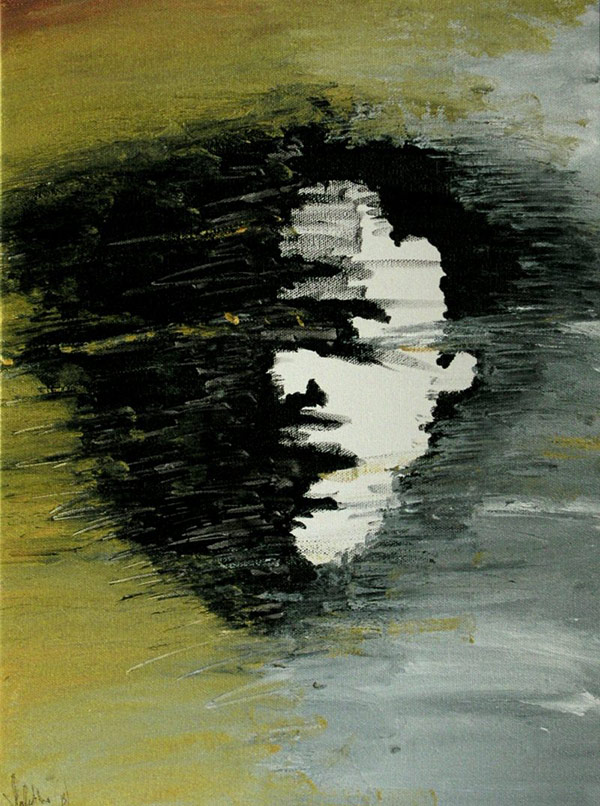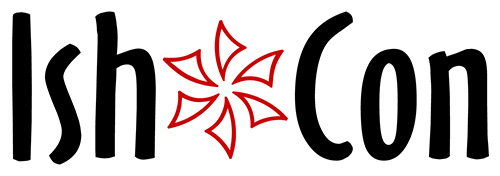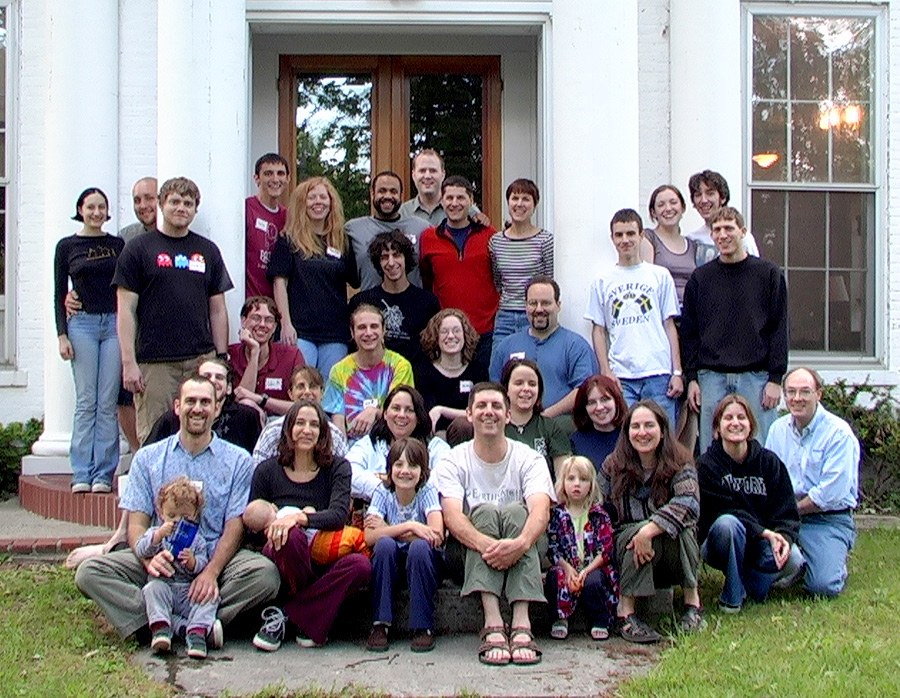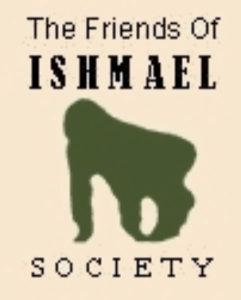From the beginning, when Daniel began hearing from readers of Ishmael the number one question asked was “What can I do to help save the world?” Daniel’s answer was always, “Do what you can, where you are.”
That’s what this section is about–people we’ve heard about who use their unique gifts, inspired by their reading of Ishmael or the succeeding books, and do what they can where they are. The stories here are just the few that we happen to know.
But there are many, many, many more. If you have a story you’d like to share about how you were inspired by Ishmael, or any of Daniel’s books, please tell us about it.
ARTWORK
My friend #danielquinn died a few months ago. I talked to him a month before he died. He was finishing his final writing called the 6th extinction.
Climate crisis and overpopulation is pushing humans and animals (same thing) towards a massive die off in a perfectly ordinary way. This subject matter is heavy for me. It’s hard to face how out of balance most of us humans are.
I do my best, in my way to face it and discuss it. Once you see it you can’t unsee it. Once you learn it you can’t unlearn it.
https://www.instagram.com/ishmael.lords
https://amp.insee.me/u/Ishmael.lords
http://www.ishmaelart.com
Ishmael had a popular life at Salisbury in the mid-nineties, being read and shared among administrators, faculty, and students. It was used as reading for incoming freshmen in their Orientation in the Wilderness program and in various classes, so it was a natural extension to add a statue of the gorilla teacher to their campus.
In July 1995 Daniel received a letter from the university executive vice president enclosing some color copies of the clay model Bart had created so that Daniel could see the work in progress. He said, “The mold has been completed and the casting will begin shortly. We expect the first casting to be available in late August or September.” As it turned out, the final piece was delivered to the school in October, but the anticipated unveiling and dedication of the sculpture had to be put off until Earth Day, April 22, 1996.
The photos here will give you an idea of the sculpture – from its initial clay model in the artist’s studio to it’s final resting place in the Salisbury campus outdoor art collection. You can find out about the unveiling and dedication and see more photos at EVENTS.
But for a sense of what it was like to see Ishmael up close and personal, read this Baltimore Sun story “When a 450-lb Gorilla Says ‘Take Me Home,’ You Listen.”( In addition to the Salisbury Ishmael, several other sculptures were cast and made available for sale by the artist.)
 Clay model of Ishmael
Clay model of Ishmael
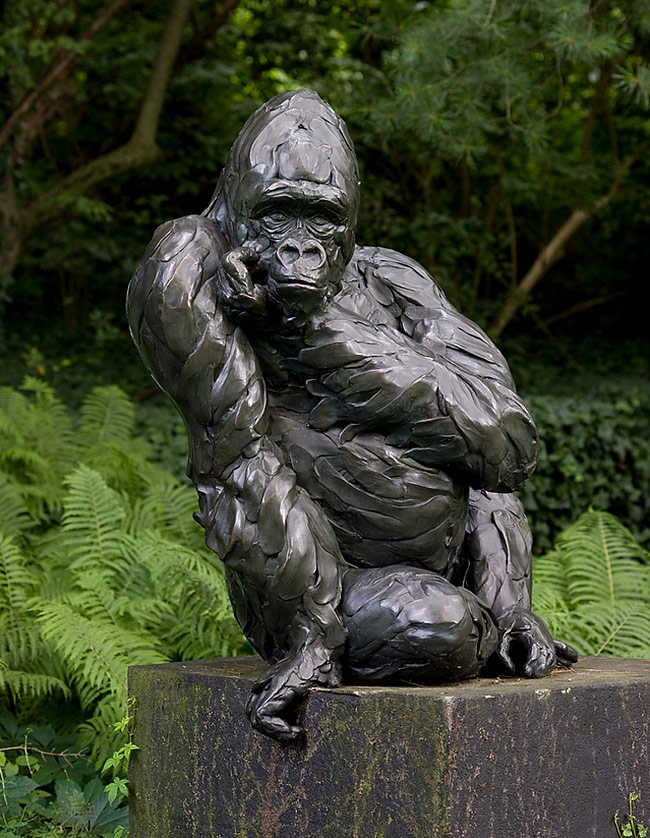 Finished bronze of Ishmael on Salisbury campus
Finished bronze of Ishmael on Salisbury campus
Cartoonist Stuart McMillen provides an excellent example of the principle that everyone has to do what is within his or her range of talents and circle of influence in relating to others their experience.
His two-part comic, “The New Purpose,” which he says is inspired by Ishmael and the idea that “You have to give them a new story to replace it.”
You can see it in its entirety here: http://www.stuartmcmillen.com/comic/purpose.
Here’s what Joel said about himself and this painting, for which he used a website photo of Daniel as the model:
“I’m just an amateur self-taught painter from Mexico. I don’t consider myself an artist since I enjoy painting just like some people enjoy solving jigsaw puzzles. That’s why I have no problem making copies of my favorite famous paintings most of the time instead of creating my own. I have a few paintings of mine but only Mr. Quinn’s books and ideas have really inspired me to strive using all I know to create this homage portrait. Hopefully I’ll continue improving in order to share his vision to others not only thru art but in anyway I can.”
See Joel’s art on: https://www.flickr.com/photos/joelmontesgarza/
MUSIC
“This Daniel Quinn book, Ishmael…I’ve never recommended a book before,
But I would actually, in an interview, recommend it to everyone….”
– Eddie Vedder
Yield album
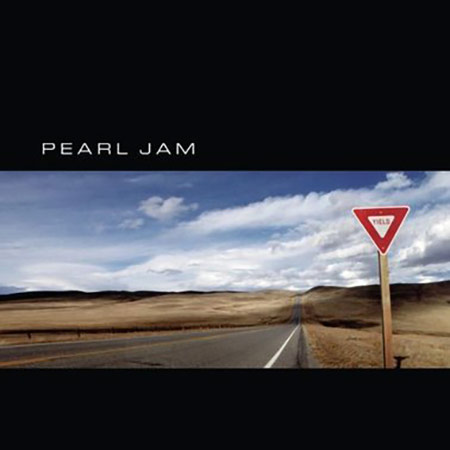
The album title is rooted in the idea of “yielding to nature,” a theme central to Daniel Quinn’s novel Ishmael. The band members read the book while working on the album.
Lyrically, Yield continued with the more contemplative type of writing found on No Code. Vedder said that while “in the past we got really angry and we cried out against many things in our songs,” he considered that when “you become an adult you have to express your energy in a different way, more calm.”
This led to songs that, while not eschewing “the bad side of life,” ended up “facing it from a more positive point of view, looking for a way to solve it. In the past we said: what a shit, this stinks, that sucks, everything sucks… Now it’s time to say: stop, let’s look for a solution, let’s be positive.”
Do the Evolution – song and video
When speaking about “Do the Evolution”, Vedder stated, “That song is all about someone who’s drunk with technology, who thinks they’re the controlling living being on this planet. It’s another one I’m not singing as myself.”
Pearl Jam has stated that the novel Ishmael influenced the writing of Yield, and according to the novel’s writer, Daniel Quinn, this song comes the closest to expressing the ideas of the book.
Vedder quoted in an interview with Dave Marsh for Addicted to Noise – Pearl Jam’s New Day Rising, 1998:
“Things have changed so much in the last 30 years. And even in the last five, with technology. And what’s gonna happen in the next 20, I don’t think we can quite grasp. So I’m nervous, and I think, I’m getting into some kind of spiritual path here, but … This Daniel Quinn book, Ishmael... I’ve never recommended a book before, but I would actually, in an interview, recommend it to everyone. I think recommending books is a little pretentious, because they take time to read, and this one is maybe two or three days or something. It’s a little more of an investment than a candy bar.
But this book, it’s kind of the book of my … My whole year has been kind of with these thoughts in mind. And on an evolutionary level, that man has been on this planet for 3 million years, so that you have this number line that goes like this (hands wide apart). And that we’re about to celebrate the year 2000, which is this (holds hands less than one inch apart).
So here’s this number line; here’s what we know and celebrate. This book is a conversation with a man and an ape. And the ape really has it all together. He kinda knows the differences between him and the man, and points out how slight they are, and it creates an easy analogy for what man has done, thinking that they were the end-all. That man is the end-all thing on this earth. That the earth was around even so much longer before the 3 million years. Fifty million years of sharks and all these living things. Then man comes out of the muck, and 3 million years later he’s standing, and now he’s controlling everything and killing it. Just in the last hundred! Which is just a speck on this line. So what are we doin’ here?”
“This is just a good reminder,” he added. “And I’m anxious to see what happens. You know, I’ve got a good seat for whatever happens next. It’ll be interesting.”
Pearl Jam also held a contest for their fan club in which members were asked to create a work of art displaying what Ishmael meant to them. The band said in their fan club letter, “This book was passed around during the last recording session, and we pass it on to you… You could almost go as far as saying that the liner notes to the record are in there.”
https://pearljam.com/
https://www.instagram.com/pearljam/
https://www.facebook.com/PearlJam
https://www.facebook.com/EddieVedder/
Wikipedia links:
https://en.wikipedia.org/wiki/Yield_(album)
https://en.wikipedia.org/wiki/Do_the_Evolution
Addicted to Noise, Dave Marsh interview with PJ – read the Ishmael part here and the entire article here.
Thank you WayBack Machine!
In the summer of 1998 Scott Valentine, aka Scotty Tuesday, arrived in Houston from Canada with his guitar and a self-portrait (the only painting he ever did) as a gift to Daniel, which he said he was compelled to create to show how he felt before and after reading Ishmael.
Scott participated in the seminar sessions with Daniel that summer and also spent many hours in dialogue with him, in much the same way as the student in If They Give You Lined Paper, Write Sideways.
He’s always been working to translate what he learned into his own way of expressing the message, and his way was music. “The Greatest Message of Hope” is a song Scott wrote featuring live excerpts from “The Ishmael Imperative,” a talk Daniel gave at gave at Rice University’s Hammond Hall in 1998.
The Greatest Message of Hope
A song by Scotty Tuesday with the words and voice of Daniel Quinn.
Listen on Spotify
FILM/VIDEO
About Greg Lowe’s film, The Eighth City, Daniel said: “From now on, when people ask me, ‘What’s it about?’ (meaning Ishmael) I’m going to send them to The Eighth City. It doesn’t say a word about ‘what it’s about,’ it shows what happens to those who read it (which is all that counts).”
You can watch the terrific 22-minute film here or on Vimeo: https://vimeo.com/70997953
Find out what Greg Lowe’s NeoTribalist Films has in the works now at http://www.neotribalistfilms.com
It was created by Juliann Bi when she was a junior in high school after after reading Ishmael for an AP Environmental Sciences class. The assignment was: read the book, then produce a project to demonstrate your understanding of the differences between Leavers and Takers.
In a note to us, Juliann said, “The film, to be honest, was a spur-of-the moment decision for me. I would’ve just done an old school poster presentation, but I decided to try the iMovie that’s been wasting away on my laptop for about a year now.”
We’re delighted she didn’t settle for just a poster!
https://docs.google.com/file/d/0B1hIAbBD0rpEY21vYmRicDY5WDA/edit?pli=1
This YouTube review does an amazing job of answering that question in under two minutes!
Daniel said about it, “I couldn’t have done better (or even as well).” It will remind you of all the things you love and admire about this book, but that’s not really the point. It’s tailor-made for you to give to people who ask that dreaded question, “What’s it about?”
It’s simply a terrific tool for anybody who’s said to their friends, “You’ve GOT to read this book!”
Watch it here: https://www.youtube.com/watch?v=7um8unEn4hU
DANCE
When she was just 17 and a student in the Pittsburgh Ballet Theatre Pre-Professional Program, Jennifer Grahnquist created two short ballets, “Vie” and “Travail and Jeu”, which you can view here.
Her first, “Vie” grew out of her reading of Ishmael. The second, “Travail and Jeu” (Work and Play), is based on the “Tunes & Dancers” chapter of My Ishmael.
Jennifer is now a teacher at a Waldorf school and she dances, sings, and acts in her local community theater.
WRITINGS, TALKS, REVIEWS, TRIBUTES
At the 2011 International Conference on Sustainability, Transition and Culture Change: Vision, Action and Leadership, Timothy Bennett, director of the film What A Way to Go: Life at the End of Empire and author of the novel All of The Above, spoke eloquently on Daniel’s work.
Tim said his aim in his talk was not to speak for Daniel . . . but to bring him into the room as a living, vital soul whose work “lives in me . . . taking the way of seeing that you first showed me was possible and focusing it on the matters of vision, action, and leadership on which the conference is focused.”
After listening to Tim talk, Daniel wrote to him, “You have revived hope in my own usefulness!”
In his Chicago Tribune article “Ishmael by Daniel Quinn and the movement it inspired” Pete Reinwald takes a new look at Ishmael ten years after his first reading of it.
‘Ishmael’ by Daniel Quinn and the movement it inspired
By Pete Reinwald
Chicago Tribune
July 13, 2013
This is a story about a blue crab killed for no good reason.
It is a story about birth and rebirth, law and life, nature and nurture, cooperation and connection, cultivation and civilization, production and destruction, seed and greed, Adam and Eve.
It is a story about “Ishmael.”
“Ishmael,” a 1992 Daniel Quinn novel, sounded an alarm on civilization’s war on Earth, embarked on 10,000 years ago at the beginning of the agricultural revolution. It illuminated the way in which that revolution continues with blindness and madness, killing or swallowing all life — plant, creature or human — that stands in the way of its appetite for expansion. It urged us to wake up.
The book inspired discussion groups worldwide through The Friends of Ishmael Society, and it prompted schools and teachers to include it in their curricula. Some still do.
I came upon the book almost 10 years ago during a time in which my heart — perhaps remembering a life-inspiring lesson from childhood — beat for books about the natural world, especially those that carried a historical, cultural or spiritual component. Thoreau’s “Walden” begot Derrick Jensen’s “A Language Older than Words,” which begot Riane Eisler’s “The Chalice & the Blade,” with some Barbara Kingsolver mixed in. The latter two books beautifully bemoaned loss — “Language” the loss of our connection to the stars and streams, “Chalice” the loss of our connection to the sacred feminine. Both books explored an insane world run by men.
“Ishmael” featured an inviting subtitle: “An Adventure of the Mind and Spirit.” It also carried on the cover this blurb by Jim Britell of Whole Earth Review: “From now on, I will divide the books I have read into two categories — the ones I read before Ishmael and those read after.”
I now divide the books I have read into two categories — the ones that slap me in the face and the ones that don’t. “Ishmael” slapped me in the face: Humanity isn’t destroying the earth. One culture that now rules the globe is destroying the earth. That is our culture, whose objective is to bulldoze everything in its way and to put everybody at the wheel. The objective is food production and growth, and the target is any forest and any life — plant, animal or human — that occupies it. This is true whether in Brazil, China, Russia or the United States. Our culture won’t stop until it devours everything, including itself.
My grandparents passed this culture to my parents, who passed it to me. I passed it to my kids, who no doubt will pass it to theirs. We do so unwittingly, much the way we commuters sleepwalk en masse from the train to our office buildings, unconscious but of our iPhones. As the book points out, we’re on a crash course.
I’ve been thinking about “Ishmael” lately because of a new book I just finished: “Life’s Operating Manual,” by Tom Shadyac, director of films such as “Bruce Almighty” and “Ace Ventura: Pet Detective.” I read it because of the story of Shadyac, who sold his Hollywood mansion and moved into a mobile-home park. He writes in his book that he did that and gave away money because “it felt like the right thing to do.”
Shadyac’s book, broader in its cultural message and more spiritually focused than “Ishmael,” told me little new. But it did offer strong reminders on ideas that resonate with me, such as the value of true wealth over material wealth (“I do not wish to redistribute wealth; I wish to redefine it,” Shadyac writes); the problem of a cultural mentality that inspires competition and profit over cooperation and people; and the importance of our culture to recognize and embrace our connection to all things — each other and nature.
The book also pays tribute to “Ishmael” and to Quinn, its author. Shadyac writes: “Ishmael” grabbed “me by my throat in a literary vise grip. Quinn’s chokehold is rooted in a simple idea: that our culture has seduced us, hypnotized us really, into wholeheartedly embracing a way of life that may have little to do with reality.”
Shadyac’s book prompted me to read “Ishmael” again and to write about it.
Early in the book, a man, the narrator, answers a newspaper ad that says:
“TEACHER seeks pupil. Must have an earnest desire to save the world. Apply in person.”
The narrator meets the teacher — Ishmael, a thousand-pound gorilla who communicates telepathically. Using the Socratic method, Ishmael implores the narrator to think for himself on “how things came to be this way” and to come to the understanding that our culture has been enacting a story from the book of Genesis: that Man is here to conquer the earth.
Ishmael separates humans into two groups — “Leavers” and “Takers.” “Leavers” formed cultures that thrived for thousands of years before the agricultural revolution — hunters and gatherers, herders, indigenous societies. Those cultures lived lightly and took only what they needed. “Takers” are us — the people who killed or annexed those cultures and continue to do so; logging and farming in the Amazon threatens some of the last uncontacted tribes on Earth.
“Mother Culture teaches you that this is as it should be,” Ishmael tells the narrator. “Except for a few thousand savages scattered here and there, all the peoples of the earth are now enacting this story. This is the story man was born to enact [according to the mythology], and to depart from it is to resign from the human race itself. . . . There’s no way out of it except through death.”
Unlike “Leaver” societies, which sustained themselves and the natural world for thousands of years, our “Taker” society will run out of things to kill and will die. Quinn likens the agricultural revolution to humans’ first attempts at flight. Those attempts failed because we tried to mimic a bird. Only when we discovered the law of aerodynamics did we learn to fly.
Through “Ishmael,” Quinn argues that no law or theory underpins “Taker” culture — and that’s why it has been in free fall since its adoption.
Quinn emphasizes that the natural world, which includes “Leaver” cultures, sustains itself through what he calls the law of limited competition. Under this peace-keeping law, he says, you may not hunt down competitors or deny them food or access to it. You also may not commit genocide against your competition.
“And only once in all the history of this planet has any species tried to live in defiance of this law — and it wasn’t an entire species, it was only one people, those I’ve named the Takers,” Ishmael tells the narrator. “Ten thousand years ago, this one people said, ‘No more. Man was not meant to be bound by this law,’ and they began to live in a way that flouts the law at every point.”
People have asked me why I don’t just become a hunter-gatherer. I have no interest in becoming a hunter-gatherer — and I know my wife, who focuses on the good in our society, wouldn’t, either. I wouldn’t know what to do and especially where to go. My problem is less with civilization than the aggressiveness and mindlessness of this one. As Quinn points out in “Ishmael,” civilization isn’t against the law of limited competition; it’s subject to the law of limited competition.
While writing this essay, I took a break to go with my wife and son to see the Chicago Symphony Orchestra perform at the Morton Arboretum. As I listened, I thought about all the beauty this culture has produced.
Yet I yearn to live in a civilization that blends less madness with its music. I yearn to live in a civilization that redefines not only wealth but profit. A new shopping center and fast-food restaurant turns up trees by the roots but lifts no spirit. A lawn built on chemical products kills the dandelion but misses the miracle. A daytime flight over Chicago anticipates the skyline but ignores the slaughter. I yearn to live in a civilization that aviates consciously.
I know of like minds who found inspiration in “Ishmael.”
“When I was a legal advocate for chemical victims, I was already well aware of the distorted values at work in our culture,” Earon Davis, a former Chicago resident who recently moved to Bloomington, Ind., wrote in an email. “‘Ishmael’ helped me to see that our entire society’s sustainability and adaptability were being jeopardized by corrupted group-think in our mainstream culture.”
Davis said he tried to establish a Chicago-based discussion group related to “Ishmael” but got limited participation. He continues to lead a Web-based discussion group, which sees little activity.
“I can see how most people who are initially drawn to ‘Ishmael’ need to back away from the message of Quinn in order to focus on earning a living, raising a family, and living a ‘normal’ life,” he wrote.
Barbara Ridd said she incorporates “Ishmael” into the curriculum of a course called Ecology of Personal Life at DePaul University’s School for New Learning. She said the book offends some students who feel it questions the Bible.
“I think that closes those people off to the greater message, that we have to take stock of ourselves,” she said. “I think that sometimes, when given such a blunt look at our existence as mankind, people don’t like that as well.”
Laura M. Hartman, assistant professor of religion at Augustana College in Rock Island, said she read “Ishmael” for two courses as an undergraduate at Indiana University. “The general concept of ‘Takers’ and ‘Leavers’ still resonates with me,” she said. Yet she sees a weakness in the book: Instead of providing instructions on how to change the world, Quinn appeals for changed minds.
“The clock is ticking,” she said. “We don’t have time to make these inner transformations.”
This essay serves as an attempt to inspire transformations, anyway.
Now, about that blue crab.
I was about 9 years old. My father had long left us, and my mother had met the man who would raise me. We lived on a canal in Florida. He liked hunting and fishing, and he had a tremendous love and respect for nature. I liked baseball and football. I couldn’t bear the sight of a dead fish or animal — and I especially couldn’t kill one. So I rarely would go hunting or fishing with him.
But I desperately wanted to please him. One day, I lost my childhood senses and, for a moment, all that I loved. I spotted a blue crab in the canal in about two feet of water. I grabbed the gig that my stepfather kept by the canal. I thrust the gig into the water and speared the crab though her core. I raised the gig from the water, the crab moving its claws and legs as if searching for food or for any sense in this.
I ran joyfully to my stepfather, carrying the gig and the mortally wounded crab at the end of it as my trophy, and showed him what I’d just done for him. I told him I thought he’d want it for dinner. I expected a “that’s my boy” and a hug. I got a scolding. I got a demand that I eat what I’d just killed.
I got the lesson of my life — a lesson and law that I’ve carried with me, passed to my children and hope that they pass to theirs: You may not kill any member of the community of life for no good reason.
Pete Reinwald is the lead editor on the Tribune’s e-books project and an editor for Printers Row Journal.
Books discussed
“Ishmael”
By Daniel Quinn, Random House, 272 pages, $18 paperback
“Life’s Operating Manual”
By Tom Shadyac, Hay House, 247 pages, $19.95
More Daniel Quinn
Quinn, who attended Loyola University Chicago, expands on his urgent cultural theme in “The Story of B,” which is every bit as good as “Ishmael” — some say better — and can be read first. He wraps up a trilogy of sorts with “My Ishmael.”
Click here to read the article on the Chicago Tribune’s website.
Copyright © 2019, Chicago Tribune
The Unsustainability and Origins of Socioeconomic Increase
A master’s thesis for the City University of New York Graduate Center’s Master of Arts in Liberal Studies program
by Mark S. Meritt
About Mark’s master’s thesis Daniel said, “Incredibly, you’ve made more sense of my ideas than I knew was there! (And negotiated your way around all the pitfalls that suck in so many of my readers.)”
Download the PDF of The Unsustainability and Origins of Socioeconomic Increase
Mark S. Meritt’s website:
http://potluck.com/2001/01/the-unsustainability-and-origins-of-socioeconomic-increase/
Daniel Quinn, Teacher, Author of Ishmael, Dies at 82
by j. Snodgrass
Vine Deloria wrote,
“When ecologists find a predictable life-span of a generation separating us from total extinction, it would seem that we have a duty to search for another interpretation of mankind’s life story.”
Daniel Quinn responded:
“What a curious thing to say.
Because we’re on the verge of extinction, we should look for another interpretation of mankind’s life story?
What difference does a story make?
It makes a difference. Because the story we have, we are enacting.
We are making it come true.
And in making it come true, we are pushing ourselves toward extinction.”
(Daniel Quinn, The Book of the Damned)
…
What difference does a story make?
In Daniel Quinn’s books, he examined the fundamental narratives of our culture – pessimistic stories about humanity being naturally destructive, damned and doomed from the start. He took what I had been taught about “human nature” and exposed it as mythology.
He also warned that these myths were self-fulfilling prophecies – when we think of humanity as “fallen” or “cursed” it can give us permission to live in destructive ways.
But Quinn’s writings were not hopeless. Rather, he encouraged his readers to re-examine the story our culture is telling and enacting, and consider a more positive and sustainable story we could be living in.
Read the rest of the article here.
Lisa Wells read Ishmael when she was 16 and then when on a life changing journey, finally winding up for a chat in the living room of Rennie & Daniel Quinn.
Read her story here: https://nplusonemag.com/online-only/online-only/the-blaze/
Sam Sycamore, a writer, musician, and radical ecologist from Kentucky, (currently residing off-grid in the mountains of Santa Cruz County, California) did a wonderful podcast tribute to Daniel. In the preamble to his podcast Sam eloquently writes:
“For those of us seeking an alternative way of life outside the confines of civilization, Daniel Quinn has had an immense impact on our collective worldview through this bold and unique books.
Beginning with Ishmael, in which we are introduced to the kinds of insights about civilization that only a captive gorilla could elucidate, Quinn took a fearless approach to questioning the very roots of our modern society, and dissecting the absurd narratives that we tell ourselves regarding our participation in the calamitous mess of civilization.
Most important, though – I think – is his message that the world doesn’t need to be saved because we as a species are simply not capable of destroying it in the first place. Furthermore, humanity itself is not the cancer on the Earth’s surface that many would have you believe it is. It’s just this one culture that has come to dominate the global landscape, as well as the inner landscapes of our minds, that now threatens life (as we know it) on this planet.
Because of course, civilization is not merely a place—it’s a way of organizing your lifestyle and orienting your goals as a community. And it’s not a very good one, either.
What comes “beyond” civilization? Quinn couldn’t tell us precisely, and neither can I. But now that he has passed, it’s up to us to work it out. I hope you’ll join me in doing just that.”
Thank You, Daniel Quinn, For Convincing Me Not to Save the World
You can listen to it here: http://thegoodliferevival.com/podcast/34
Ryan Cove used to work as a bookseller and Ishmael was his “staff pick”. Ryan sold over 5,000 copies of Ishmael!
In this video he gives his “sales pitch” to customers for his favorite novel of all time, Ishmael by Daniel Quinn.
Why you should read Ishmael by Daniel Quinn:
https://www.youtube.com/watch?v=j72RINAQ-ZQ
ORGANIZATIONS
Chris Hardie, and a few other Ishmael fans, started an organization called IshCon. From 1999 to 2007 it was a thriving online community that also had many in-person conferences and events.
In April 2019 Chris wrote a tribute to Dan and in it Chris talks about IshCon and the history of that organization.
Remembering Daniel Quinn
April 2, 2019
Chris Hardie
excerpt…
I do not claim to have known Dan very well, but every time I talked with him or saw him in person, I experienced him as a grounded, authentic, kind, and intensely intelligent person. He had a contemplative nature, and I always appreciated that when asked a question about his work or his ideas, he would listen carefully and then pause for as long as he needed to provide a thoughtful, intentional answer. If he didn’t know or couldn’t form a useful response, he just said so. He was keenly aware of the power of words to persuade, convince, change minds and alter the course of history, and so he also seemed wary of uttering something that could be misinterpreted, re-appropriated or used to stuff his very not-mainstream ways of thinking into a comfortable mainstream box. He didn’t have much patience for people who weren’t trying to think for themselves or learn from past mistakes.
Because of the power of his books, many people wanted Dan to be their leader: the leader of their movement or their project or their personal journey through the world, or all of the above. I was always careful about not worshipping Dan himself or of not elevating his writing as sacred texts. But I guess I did help to start a group of people and a series of events centered around his work that jokingly referred to ourselves as a “cult of Ishmael” — sorry, Dan.
That group and those events were called IshCon…click here to read the entire article
In 2002 The Friends of Ishmael Society was originated by, and organized and coordinated directly by, readers who were inspired to publicize the work of Daniel Quinn. It was a way to help coordinate and offer tools to the many readers throughout the world working to spread the message of Daniel’s work.
Its website contains a wealth of information–about what readers have been inspired to do, connecting with local groups, tools for reaching out to others, and more. The Society is in no way connected to Daniel, but it has proved a valuable asset for countless readers of his work.
The ishmael Society website may be useful for those of you who have not latched onto social media as your main connection to others, and would rather connect to local groups (though these groups may no longer exist).
Check it out here: http://www.friendsofishmael.org/index.shtml (Please note that many links from this site may no longer be valid.)
ReadIshmael.com another website created by readers that’s been around for a long time, so we can’t guarantee that all the links work or that all the information is correct or up-to-date.
Check it out here: http://www.readishmael.com/readishhome.html
CORPORATE CULTURE
In 1994 Daniel received a letter from Ray Anderson (1934-2011), founder and CEO of Interface, Inc., the world leader in modular carpeting. In it he said that after a speech he gave at Georgia Tech, a professor in the audience sent him a copy of Ishmael.
Ray had already begun the work of transforming Interface into a model of sustainablilty, spurred on by Paul Hawken’s The Ecology of Commerce, another book that had been sent to him out of the blue.
After Ray’s death, an Interface employee wrote to Daniel and told him that, as important artifacts to honor Ray’s life were gathered, his personal and dog-eared copies of Hawken’s and Quinn’s books were side-by-side in a place of honor. “[Ray] always described them as the source of the ‘What and Why’ of his vision. In his mind, neither would have been sufficient to establish the breadth of his vision or the depth of his resolve.” (Hawken tells what’s wrong, and Quinn explains why.)
With a changed mind about corporate responsibility, Ray transformed his company into a stellar example of how a multinational corporation can significantly reduce its environmental footprint while maintaining and improving profitability.
He steered the company away from the typical take-make-waste business model toward one that’s renewable, cyclical, and benign. In 1994, Interface, Inc., pledged to reduce their negative impact on the environment with Mission Zero. They are poised to meet their goals by 2020.
Daniel was invited to be the keynote speaker at the 1995 “VISION 2000: Renewing the World Within” conference organized by Interface. Please see EVENTS for more info on that fantastic conference.
The story of Ray Anderson and Interface was always told by Daniel as an example of what one person could do to effect change in his or her particular sphere of influence. “Taming the Big Bad Wolf” in ESSAYS is Daniel’s telling of that story.

The Ray C. Anderson Foundation is a not-for-profit 501(c)3 organization whose mission is to promote and advance the concepts of sustainable production and consumption.
PHOTO OP
Longtime supporter and promoter of Quinn books, Howard Ditkoff, found a unique opportunity to introduce them in the photo accompanying an article that appeared in his local newspaper about him and a surprising career switch.
See it here: http://beingatwork.com/Articles/TDN-12-04-06.htm
GAMES
This very deep and sophisticated role-playing game called “The Fifth World,” was created by Jason Godesky, who said that he spent “the better part of a decade” designing this game, which is “intended to draw players into an animist experience and present a positive vision of the sort of neotribal future we could one day create.”
How did the Fifth World get to be the fifth? The First was The world before life; Second, The world of life before Man; Third, The world of Man before the birth of civilization; Fourth, The world of civilization; and Fifth, The neotribal world that emerges after the collapse of civilization.
Enter it here: https://thefifthworld.com/

